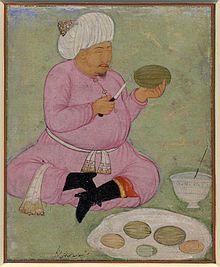Abdullah II (Bukhara)
Abdullah II. (* 1533 - † February 4, 1598 in Samarkand ; actually Abu'l Gazi Abd Allah b.Iskandar , also Abdullah Khan or Abdallāh ) was prince of the Uzbek Khanate of Bukhara from the Scheibanid dynasty and one of the most important rulers of Bukhara . His reign from 1583 to 1598 represented an economic and cultural heyday for his country.
Live and act
Abdullah II. Was the son of Iskandar (ruled 1561–1583) and ruled in Bukhara since 1556, while his uncle Pir Muhammad (ruled 1556–1561) and his father ruled successively in Samarkand. Neither cared much about the government. It was Abdullah who successively eliminated the rival families and appropriated their properties, with the exception of a relative named Baba Sultan, who lasted until 1582. After the death of his father, Abdullah II also became the overlord of the Uzbek princes (1583–1598). With the (relatively) peaceful rule of the aforementioned princes, 17 years of internal power struggles ended.
Abdullah's long reign was considered the "good old days" of the Uzbeks. Like the Timurids before, he promoted courtly miniature painting and architecture, so that most of the large buildings in the country were attributed to him (for example the construction of the Abdullah Chan mosque in Sumitan near Bukhara 1560–1563, the Kukeldash madrasa in Tashkent 1568– 1569 and the Abdullo Khan Mosque in Isfara ). Since then, the Uzbeks have slowly settled down and even settled in the cities.
The Uzbeks in Central Asia benefited from the caravan trade via Herat, which was still growing up to the turn of the 17th century . Apparently it was due to the unloved rule of the Portuguese off the Indian coast that many traders once again turned to the caravan routes. Carpets from Bukhara were traded as far as Italy . Nevertheless, there is also the opinion (based for example on an eyewitness report by the English adventurer A. Jenkinson) that Bukhara was less prosperous at the time of Abdullah II than in the 15th century.
Abdullah II was an Orthodox Muslim who drove the philosophy students from Bukhara and Samarkand, which initiated a spiritual stagnation in his country. Instead, dervish orders (such as the Naqschbandi ) spread further and were very revered in the lower classes.
In terms of foreign policy, the Uzbek Khan was in alliance with the Ottoman Sultan Murad III. against Persia . His interest focused on Khorassan : in 1585 he took Herat and Merw and subsequently plundered several cities, including the famous pilgrimage site of Mashhad . He also had to deal with Baba Sultan and the Kazakhs who were threatening Tashkent. Here he penetrated far into the Kazak steppes in 1582 - allied with Shigai Khan - but that remained an episode. Abdullah II was also allied with the Sibir Khanate . The Siberian Khan Kütschüm (r. 1563–1598) may have grown up in Bukhara - at least he relied on missionary Bucharian Muslims. Relations with Mughal Mogul Akbar I in India were peaceful, although not without tension. For example, Abdullah sent an embassy to investigate rumors that Akbar had fallen away from the Islamic faith.
The Khan experienced the decline of his state: the plague decimated the people in 1590/1591 and the land south of the Amu-Darya was finally lost to the Iranians , which cut Uzbekistan off from the developing world trade. Shah Abbas had allied himself with the Khiva Khanate, threatened by Abdullah, and recaptured Herat and Mashhad (1595/96), among others. From 1595–98, Abdullah occupied the Khiva Khanate. Abdullah's son Abdul Mu'min rebelled to 1597. Seizing this opportunity, grabbed the Kazakhs -Khan tawakkul (reigned 1575 / 86-1598) to: tawakkul crossed the Syr Darya , defeated the Uzbeks, occupied Tashkent , Samarkand and Jassy and was only after Abdullah Death brought to a standstill near Bukhara in 1598. The Khan had meanwhile died in Samarkand.
After his death in 1598 ruled briefly his rebellious son Abdul Mu'min and a cousin named Pir Muhammad, 1599 after joining the dynasty of the Astrakhan fled Dschaniden whose prince had married into the Shelbanides-ruling family.
literature
- Jürgen Paul: New Fischer World History , Volume 10: Central Asia. 2012
- Lazar Israelowitsch Albaum, Burchard Brentjes : Lords of the steppe. On the history and culture of Central Asian peoples in Islamic times. German Science Publishing House, Berlin 1986
- Henry Hoyle Howorth: History of the Mongols from the 9th to the 19th Century. Part 2. The So-Called Tartars of Russia and Central Asia . London 1880 ( at Internet Archive )
Remarks
| personal data | |
|---|---|
| SURNAME | Abdullah II |
| BRIEF DESCRIPTION | Uzbek prince |
| DATE OF BIRTH | 1533 |
| DATE OF DEATH | February 4, 1598 |
| Place of death | Samarkand |
